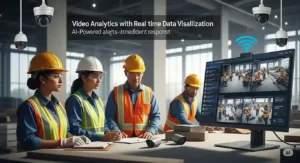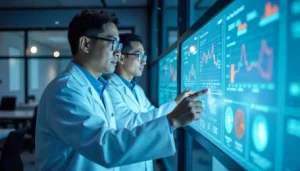Introduction
Employee safety is a paramount concern for organizations worldwide. In an era where technological advancements are reshaping various aspects of our lives, leveraging cutting-edge solutions becomes imperative to ensure a secure working environment. One such revolutionary technology making waves in the realm of occupational safety is the integration of Advanced Vision Inspection Systems.
The Current Landscape of Workplace Safety
In today’s fast-paced work environments, the safety of employees is often at risk due to various factors. Workplace accidents and injuries not only affect the well-being of individuals but also incur significant costs for companies. Addressing these challenges requires a proactive approach, and this is where advanced vision inspection systems come into play.
Role of Vision Inspection Systems in Employee Safety
Advanced vision inspection systems act as vigilant guardians, constantly monitoring the work environment to identify potential hazards. Unlike traditional safety measures, these systems utilize state-of-the-art technology to detect and prevent accidents before they occur. The real-time nature of these systems adds an extra layer of protection, significantly reducing the occurrence of workplace incidents.
Key Features of Advanced Vision Inspection Systems
These systems boast high-resolution imaging capabilities, allowing for precise identification of safety risks. Real-time monitoring ensures that any anomalies are detected immediately, enabling swift corrective action. Moreover, these systems seamlessly integrate with other safety measures, creating a comprehensive approach to employee well-being.
Implementation of Vision Systems in Different Industries
From manufacturing to healthcare, numerous industries have embraced advanced vision inspection systems. Case studies reveal remarkable success stories, where the implementation of these systems has led to a substantial reduction in workplace accidents. The adaptability of these systems to various work environments makes them a versatile solution for maximizing employee safety.
Addressing Challenges and Concerns
While the benefits of vision inspection systems are evident, there are common misconceptions that need to be addressed. Some fear implementation challenges, such as system complexity or resistance from employees. However, with proper education and support, these concerns can be overcome, ensuring a smooth transition to a safer work environment.
Training and Education for Effective Use
Ensuring the effective use of vision inspection systems requires comprehensive training programs. Educating employees about the functionality of these systems fosters a sense of confidence and cooperation. By creating a workforce that understands the value of these safety measures, organizations can enhance their overall safety culture.
Cost-Benefit Analysis
Investing in advanced vision inspection systems may seem like a significant financial commitment initially. However, a thorough cost-benefit analysis reveals that the long-term savings associated with improved safety far outweigh the initial investment. The reduction in workplace accidents not only saves on medical costs but also enhances productivity and employee morale.
Regulatory Compliance and Standards
Adhering to safety regulations is a critical aspect of any business operation. Vision inspection systems play a vital role in ensuring compliance with safety standards. Their ability to provide accurate and real-time data aligns seamlessly with regulatory requirements, helping organizations avoid penalties and legal complications.
Future Trends in Employee Safety
As technology continues to evolve, so do the trends in employee safety. Emerging technologies, such as artificial intelligence and augmented reality, are expected to further enhance workplace safety measures. Predictions indicate a future where the integration of these advancements will create even safer work environments.
Employee Feedback and Satisfaction
The impact of a safe work environment on employee satisfaction cannot be overstated. Surveys and testimonials from employees in organizations using vision inspection systems consistently highlight a sense of security and well-being. This positive feedback contributes to a healthier organizational culture and employee retention.
Continuous Improvement Strategies
To maintain the effectiveness of vision inspection systems, continuous improvement is essential. Regular updates and feedback loops ensure that the technology stays ahead of evolving safety requirements. Organizations committed to ongoing enhancement of their safety measures are better equipped to adapt to changing workplace dynamics.
Global Adoption of Vision Inspection Systems
The adoption of vision inspection systems is not confined to a specific region. Global trends indicate a widespread recognition of the value these systems bring to employee safety. As international standards for occupational safety evolve, the integration of advanced vision inspection systems is becoming a benchmark for responsible and forward-thinking businesses.
Conclusion
In conclusion, maximizing employee safety through advanced vision inspection systems is not just a technological upgrade but a transformative journey toward creating secure workplaces. The combination of real-time monitoring, high-resolution imaging, and seamless integration with existing safety measures positions these systems as indispensable tools for organizations striving for excellence in occupational safety. Follow our LinkedIn page for the latest insights and updates on how VIS are revolutionizing employee safety.
FAQs
- Are vision inspection system suitable for all industries?
- Yes, these system are adaptable and have been successfully implemented in various industries, including manufacturing, healthcare, and logistics.
- What is the typical return on investment for implementing vision inspection system?
- The return on investment is substantial, considering the long-term savings from reduced accidents, improved productivity, and enhanced employee morale.
- How do vision inspection systems contribute to regulatory compliance?
- These systems provide real-time data and monitoring, ensuring organizations meet and exceed safety standards set by regulatory bodies.
- Can vision inspection system be integrated with existing safety measures?
- Yes, one of the key features of these systems is their seamless integration with other safety protocols, creating a comprehensive safety net.
- What is the future outlook for employee safety technologies?
- The future of employee safety technologies looks promising, with advancements such as artificial intelligence and augmented reality playing a significant role in shaping safer workplaces.







